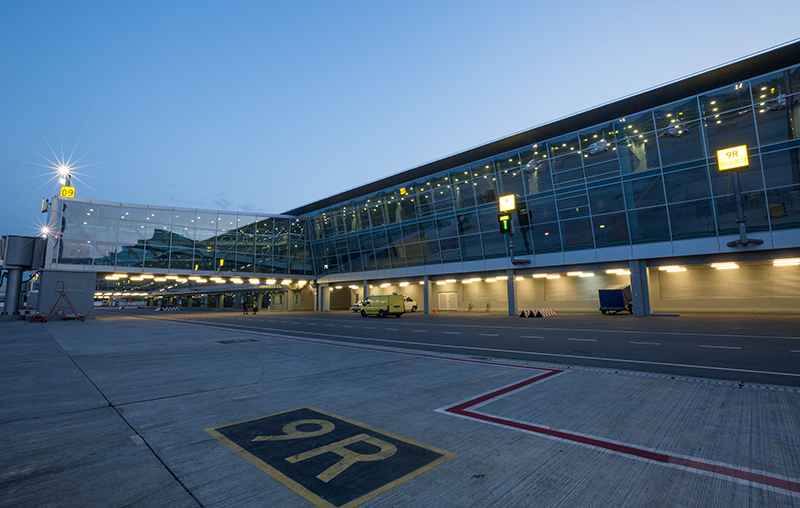
In the fast-paced and safety-critical world of aviation, precision and efficiency are paramount. The process of docking an aircraft at the gate has traditionally relied on manual guidance from ground personnel, leaving room for human error and subjective estimations. However, with the advent of the Visual Docking Guidance System (VDGS), a revolutionary technology has emerged, reshaping the way pilots navigate the complex task of parking an aircraft. By combining advanced sensors, high-resolution cameras and intelligent algorithms, the VDGS provides pilots with real-time, precise guidance, ultimately enhancing safety, optimizing operational efficiency and reducing costs.
The VDGS utilizes a network of high-resolution cameras, strategically placed sensors and intelligent software algorithms. As the aircraft approaches the gate, the cameras capture images of specific reference points on the aircraft, such as the nose wheel, main landing gear and wingtips. The collected data is then processed and analyzed by the VDGS software, which calculates the precise aircraft position and alignment with respect to the gate.
a. Enhanced Safety: The VDGS significantly reduces the risk of accidents and damage during the docking process. By providing pilots with accurate real-time information, eliminates subjective estimations and ensures precise alignment with the gate. This enhances safety for both ground crew and passengers.
b. Increased Operational Efficiency: The VDGS streamlines aircraft parking operations, reducing turnaround times and increasing gate utilization. Pilots can dock the aircraft with precision, eliminating the need for manual adjustments and minimizing the chances of overshooting or undershooting the assigned parking position.
c. Cost Savings: The VDGS offers substantial cost benefits by reducing the reliance on ground personnel for manual guidance. With automated and precise docking, airlines can optimize their ground handling resources, saving time and labor costs.
d. Weather Independence: Unlike traditional docking methods that heavily rely on visual cues, the VDGS operates effectively in all weather conditions, including low visibility situations. Pilots can rely on the system's advanced camera and sensor technologies to park the aircraft accurately, even when external visibility is limited.
The Visual Docking Guidance System continues to evolve, with ongoing research and development efforts focused on further enhancing its capabilities. Future advancements may include augmented reality overlays, 3D modeling and autonomous docking capabilities. However, challenges such as retrofitting existing infrastructure and ensuring compatibility across various aircraft types and airports remain.
The VDGS isn't just a technological marvel; it's a pilot's best friend. The VDGS becomes an extension of their expertise, simplifying complex tasks and elevating the overall flying experience. Seamlessly integrated into the cockpit, this intuitive innovation proves that technology and human skill make the ultimate dream team.
In the limitless expanse of the sky, GEMS AVDGS emerges as the ultimate catalyst, empowering pilots to navigate the docking process with unparalleled precision, safety and efficiency. This advanced system incorporates cutting-edge 3D laser technology, ensuring compliance with International Civil Aviation Organization (ICAO) Annex 14 recommendations. Furthermore, it eliminates error factors caused by variations in aircraft height and gross weight, providing accurate guidance for aircraft docking. The key advantages of GEMS' AVDGS are:
Interface Compatibility: The system is equipped with interface capabilities with various aviation-related systems, including Airport Operational Database (AODB), Information Message Broker (IMB), Unified Flight Information System (UFIS) and Building Management System (BMS). These integrations facilitate seamless communication and data exchange, which enhances overall airport operations.
Safe Dock Log Viewer: GEMS specializes in managing a Safe Dock Log Viewer, a feature that enables users to access and analyze docking log data. This functionality ensures proper monitoring and safety compliance during the docking process.
Aircraft Docking Simulation Software: This software enables users to simulate and optimize procedures for different types of aircraft. The application helps reduce turnaround times and improve operational efficiency.
At GEMS, we pride ourselves on offering cutting-edge technology, unmatched expertise in handling over 100 AVDGS for auto-docking, and an unwavering commitment to excellence. Join us and experience a transformative journey in aviation technology. Our advanced systems and solutions are designed to redefine the boundaries of precision and safety, ensuring each takeoff and landing is a seamless and secure experience.
If you need any services, drop us a mail at Rohitkumar.Singh@gmrgroup.in, or get in touch with us at +919717199753.